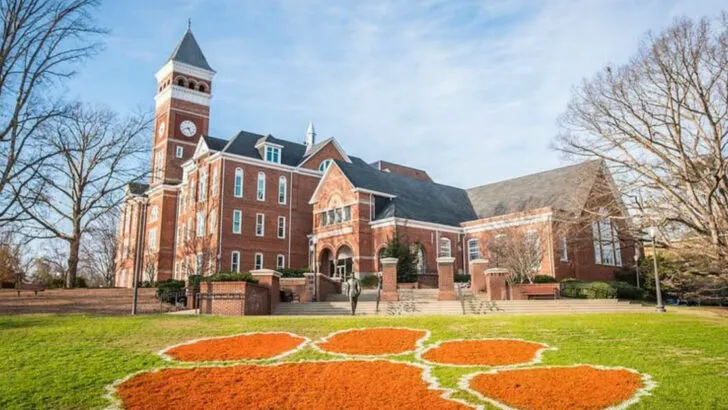This town knows how to keep a secret—and it’s a good one. Clemson, South Carolina might be famous for football, but look a little closer and you’ll find so much more hiding in the hills. Think porch swings, tree-lined streets, and a campus that looks like it was designed for fall strolls and front-porch daydreams. It’s got the buzz of a college town without the chaos. Coffee shops hum, lake views sparkle, and the mountains never feel too far away. If you’ve been hunting for that sweet spot between charm, scenery, and just enough liveliness to keep things interesting—Clemson’s been waiting. Quietly. Patiently. Like the best kind of surprise.
Oak Trees Framing the Campus Walkways
As you stroll through Clemson University’s picturesque campus, the canopy of mature oak trees offers both shade and serenity. These majestic oaks, with their sprawling branches, create an inviting atmosphere for students and visitors alike. In the fall, the leaves transform into a vibrant rust-gold tapestry, signaling the season’s change. During spring and summer, the trees hum with life, as insects and birds find refuge among the leaves. The sight is nothing short of enchanting, making it a must-see for anyone visiting Clemson.
Black-Eyed Susans in Local Meadows and Road Edges
Clemson’s landscapes are dotted with the cheerful faces of Black-Eyed Susans, their bright yellow petals catching the eye. Whether along the edges of meadows or lining the walking trails, these flowers offer a touch of sunshine. Their simple beauty and hardiness make them a favorite in local wildflower plantings. Beyond their aesthetic appeal, they play a crucial role in supporting the local ecosystem, attracting pollinators and adding biodiversity. It’s hard not to smile when these sunny blooms greet you on a leisurely walk.
Azaleas Blooming Loud and Proud in Spring
Azaleas are the crowning glory of Clemson’s spring, with their bold pinks and purples transforming the town into a painter’s palette. Gardeners and nature enthusiasts eagerly anticipate their arrival, as these blooms signal the end of winter’s chill. Nestled in gardens and lining sidewalks, azaleas create bursts of color that are impossible to ignore. Their presence is both a feast for the eyes and a harbinger of warmer days. These resilient shrubs have a charm that’s distinctly Southern, making them a beloved part of the local flora.
Eastern Redbuds Marking the End of Winter
Eastern Redbuds, often unnoticed until their blossoms appear, are a delightful harbinger of spring in Clemson. As winter recedes, these trees burst forth with tiny pink-purple flowers, adding a splash of color to the landscape. Common around parks and wooded areas, redbuds provide a gentle reminder that warmer days are near. Their early blooms offer a striking contrast against the still-bare trees, a hopeful sign of the season’s renewal. Simple yet stunning, they capture the essence of nature’s quiet transformation.
Sweetgum Trees with Spiky Surprise
Sweetgum trees add a whimsical touch to downtown Clemson, especially in the fall when their star-shaped leaves turn a medley of red, orange, and purple. As you walk the streets, watch for their distinctive round, spiky seedpods scattered along the sidewalks. These trees, with their colorful display, add vibrancy to the urban landscape. Their unique seedpods, resembling medieval maces, are both curious and captivating. Sweetgums are a testament to nature’s diversity, offering visual interest and a playful reminder of the changing seasons.
Switchgrass and Native Grasses in Sustainable Gardens
Clemson embraces sustainability, evident in its use of native grasses like switchgrass and bluestem around public buildings and gardens. These grasses, with their graceful sway, provide year-round interest and are a haven for local wildlife. Their resilience and beauty make them a staple in modern landscaping projects, contributing to the town’s eco-friendly ethos. As you explore Clemson, you’ll find these grasses creating a dynamic landscape, their movement in the breeze a dance of nature’s artistry. They reflect a commitment to preserving natural beauty while fostering environmental stewardship.
Camellias Brightening Up Quiet Corners
Camellias bring a touch of elegance to Clemson’s quieter corners, their glossy leaves and soft-petaled flowers painting a serene picture. Blooming in the cooler months, they provide a splash of color when most other plants are dormant. These flowers, often seen near historic homes and gardens, offer a classic beauty that is both timeless and inviting. Camellias are more than just eye-catching; they represent a legacy of gardening tradition in the South. Their blooms are a gentle reminder of nature’s cycles, even in the heart of winter.
Longleaf Pines on Nature Trails and Forest Margins
Longleaf Pines stand tall and proud along Clemson’s nature trails, their straight trunks and open canopies a hallmark of the Southern landscape. These pines, preserved in local nature areas, play a vital role in the ecosystem, supporting a diverse range of plant and animal life. Their presence allows sun-loving wildflowers to thrive beneath them, creating a layered tapestry of natural beauty. Walking among these giants, one can’t help but feel a sense of connection to the land’s rich history and biodiversity.
Coneflowers Drawing Butterflies on the Garden Paths
Purple coneflowers are a standout feature in Clemson’s South Carolina Botanical Garden, their vibrant blooms a magnet for butterflies. These perennials, with their striking appearance, add a structured beauty to the garden paths. As you wander through the garden, the sight of butterflies flitting from flower to flower is a testament to the rich pollinator ecosystem these flowers support. Their presence is not just ornamental; coneflowers play a crucial role in the garden’s ecological balance, offering nourishment and beauty in equal measure.
Kudzu Creeping Along Roadsides (and Everything Else)
Kudzu, with its rapid growth, is both a blessing and a curse in the Clemson area. This invasive plant, often seen draping over trees and powerlines, is a testament to nature’s unstoppable force. While its lush green vines can be visually striking, they pose challenges to local ecosystems by outcompeting native species. Despite its reputation, kudzu offers a fascinating glimpse into the complexities of plant life and environmental management. It’s a living lesson in the resilience of nature and the ongoing efforts to maintain ecological balance.
Goldenrod Lighting Up Late Summer Fields
The goldenrod, often mistaken for allergy-inducing ragweed, is a vibrant part of Clemson’s late summer landscape. Its tall yellow flowers bloom across fields, creating a stunning visual symphony that captures the essence of the season. These flowers are not only beautiful but also provide vital nourishment to migrating insects preparing for cooler days ahead.
Goldenrod’s presence signifies the transition from the warmth of summer to the crispness of autumn. Each year, residents and visitors alike admire its golden glow, a natural spectacle that never fails to captivate those who witness it.

